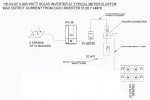I agree with BillK and what he said about breaker sizes made me think of an easy solution. Just change the 100amp breaker to a 90amp and then you don't need the added disconnect, which I don't think fixes the violation.
BillK is almost always right, but in this case he's wrong, or at least jumping to conclusions. Perhaps he assumed that the 100A breaker at the meter is on a 100A rated busbar, but that is not stated and is unlikely to be the case given that this is an apartment complex.
You haven't been very specific about the arrangement of the meters and breakers at the service equipment. But assuming each 100A breaker is indeed the service disconnect, I don't see a problem.
My only concern is if there will ever be a problem with downsizing to 90amps on a typical one or two bedroom apartment.
You'll have to do a load analysis on the given apartment, but I'd suppose problems with this would be unusual.
Another point that I think the designer missed is that he is on the load side and the Service Disconnect and is feeding the 100amp disconnect with 100 amps and 30 amps, which is more that the allowed 120%. Even though he thinks the load center is protected by the new 100 amp disconnect, the feed to the new 100 amp disconnect is in violation of 705(D)(2).
The code simply requires that all the conductors between the two fused discos and the 100A breaker be rated according to the 120% rule. The load center
is protected by the 100A disconnect (notwithstanding your concerns about delayed fuse action, the code makers were aware of that when they made the rule). Likewise, each downstream circuit supplied out of the load center is protected by its own OCPD.


